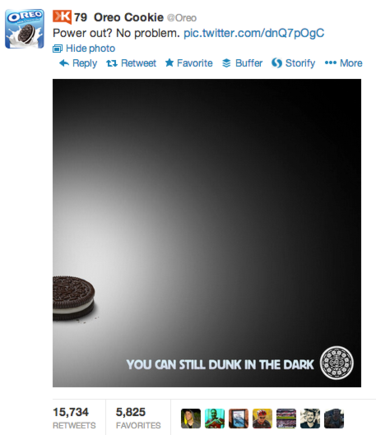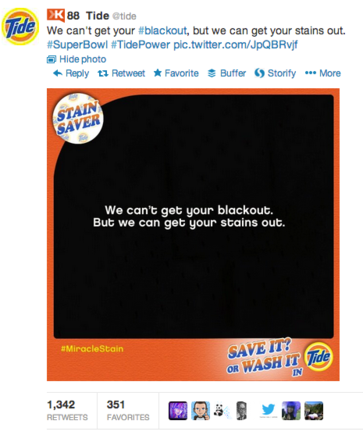Several large brands — including Oreo and Tide — took advantage of Super Bowl 47’s blackout to quickly create Twitter ads.
Oreo’s ad reminded followers that “You can still dunk in the dark,” while Tide declared “We can’t get your blackout. But we can get your stains out.” Other brands followed suit with similar tweets.

Oreo’s blackout post received more than 15,000 retweets.

Tide quickly responded with an ad about its stain fighting ability.
Relevance for Ecommerce Merchants
Empowering users to quickly respond to breaking news is one area where Twitter trumps other social networks. Twitter’s traffic volume reached 231,500 tweets per minute during the blackout, and brands like Oreo, Tide, and Audi saw their posts retweeted 1,000s of times. Oreo’s post alone received more than 15,000 retweets.
While few of us have a team of copywriters, graphic artists, and media buyers standing by to respond to news and events in real-time, here are six lessons you can learn from the Super Bowl blackout that apply to marketing via Twitter.
1. Monitor Twitter for Mentions of your Company Name and Products
People talk about brands and products — good and bad —on Twitter.
An April 2010 study by ROI Research found that 33 percent of active Twitter users share opinions about companies or products at least once per week. Thirty-two percent make product recommendations and 30 percent ask for them, according to the study.
Twitter reported that more than half of its 288 million monthly active users follow six or more brands. Companies, as such, should monitor mentions of their names and products.
You can use Twitter’s search feature to find such mentions, and then save the searches, as follows.
- Sign in to your Twitter account;
- Type a search query into the search box at the top of the page and hit return;
- Click on the gear icon and select “Save search” from the drop down menu.

You can save Twitter searches of keywords and hashtags.
To revisit a saved search:
- Sign in to your Twitter account;
- Click anywhere in the search box at the top of the page;
- A list of your saved searches will appear below the search box;
- Click on the saved search to revisit results for that query.

Click in the search field to see saved searches.
You can also use a Twitter notification service like Twilert or social media management solution such as HootSuite or Sprout Social for monitoring.
2. Monitor Product-related Keywords and Brand Names
Consumers will not likely tweet extensively about smaller ecommerce companies. That’s why it’s important to monitor product-related keywords and brand names. It could create sales opportunities.
For example, a merchant who sells wedding supplies could monitor terms like “wedding party favors,” “wedding decorations,” and “bridal registry.” Similarly, a retailer that sells cell phone accessories could monitor popular brand names such as “Samsung Galaxy” and “iPhone.”
When a tweet appears containing such keywords, introduce yourself and let the user know about your products. If the person is in the market for the type of products being sold, offer a special coupon or other incentive, and include the person in a prospective customer Twitter list in order to follow their tweets and stay in touch.
If that approach seems too promotional, simply retweet or favorite the tweet, as this can get the person’s attention and possibly lead to a follow.
In whatever manner you choose to respond, don’t neglect the opportunity to acquaint the person with your company and products.
3. Include Hashtags in Tweets
The use of hashtags — #keyword — is common among Twitter users. Hashtags filter conversations and focus on a particular topic.
Either use an existing hashtag that is relevant to the products you sell or create one of your own in hopes that others will incorporate its use.
4. Know Your Customers’ Interests
Conversations don’t always have to be about products. Pay attention to what your followers are tweeting and, when appropriate, join the conversation.
5. Use Twitter for Customer Service
A report from web analytics firm Simply Measured found that 95 percent of the world’s leading brands use Twitter for customer service, and 23 percent have dedicated customer service handles.
Such use is not relegated to top brands, as smaller merchants can take the same approach. However, remember to respond quickly, either to express appreciation for a positive mention, or to offer assistance if the tweet is negative.
6. Tap into Trending Topics
You can use Twitter Trending Topics — topics that Twitter says are the most popular — to build awareness for your business and products. That’s exactly the path Oreo, Tide and other brands took when they used the trending hashtag “#blackout” to create ads.
You can favorite, retweet, or reply to tweets listed in a Trending Topic. Use the exact keyword or hashtag from any trending topic and it will appear in the topic’s timeline.
Conclusion
The Super Bowl blackout did not just affect the tempo of the game. It also reinforced the importance of using Twitter as a marketing channel.
Take advantage of Twitter’s real-time nature to monitor mentions of your products, build awareness for your company, seek out sales opportunities, and provide prompt customer service.



